When we moved to Bolton 17 years ago, we planned to populate our wide open lawn with edible and wildlife friendly plants. At that time there was little talk of pollinators, but in landscaping for wildlife, we accidentally provided for wide variety of pollinators. What a happy accident that turned out to be, because we now recognize that worldwide, pollinators are declining at an alarming rate, due to habitat loss, climate change, pesticides, and invasive species. But there’s some good news: We can help by gardening for pollinators. Here are 8 tips, most of which we implemented in our plan for a wildlife friendly landscape.
- Avoid pesticides
- Go native
- Provide a wide variety of flowering plants
- Grow larval host plants
- Let a patch of your lawn grow weedy
- Leave dead trees and limbs
- Build an insect hotel
- Support conservation organizations
1. Avoid pesticides
By now, you’ve probably heard about the probable link between neonicotinoid pesticides and honeybee die-offs. With all the extensive testing done on pesticides, how could this have happened? Pesticides are generally tested for lethal effects on honeybees and how long the effect persists after application. They don’t test impact on all pollinators (there are too many). And they don’t test for all possible sub-lethal effects, such as mental confusion (because it’s not possible to anticipate all of them).
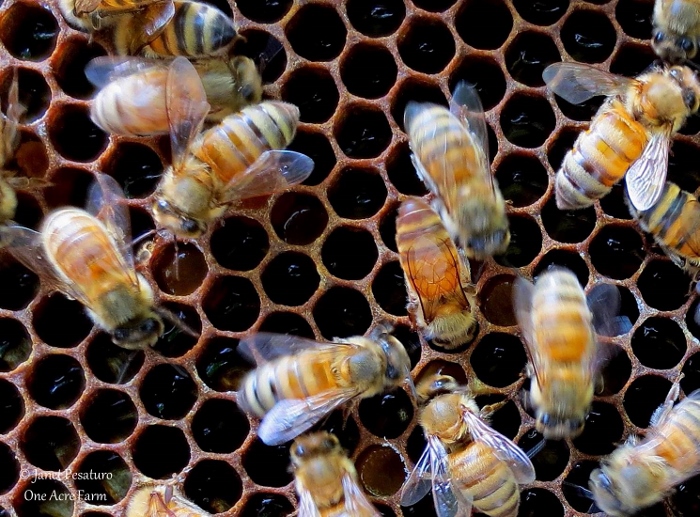
Gardening for Pollinators: 8 Tips. One tip is to avoid pesticides. Certain pesticides have been implicated in Colony Collapse Disorder, which threatens honey bees.
Sub-lethal effects might have dire consequences somewhere down the line, and go unnoticed until disaster has already occurred. Who could have anticipated that DDT, for example, would interfere with egg shell formation and cause embryonic death in predatory birds? Since we cannot foresee all of these untoward effects, it’s safest to avoid pesticides whenever possible.
2. Go native when gardening for pollinators
I don’t know about you, but I find the focus on “native” species distasteful. It smacks of both xenophobia and hypocrisy. After all, humans are not native to North America, having arrived some 15,000 years ago. To accept biologists’ recommendations that we encourage native species and discourage non-native ones, you have to accept the notion that what’s good for us humans, is good, period. Since I want to survive, I do accept it, (but with a few caveats, which I might take up in a future post).
The fact is, we humans depend on functioning ecosystems for the services they provide us: food, clean water, clean air, climate moderation, pollination, etc. If we want those services, we need to keep ecosystems functioning properly. In the case of pollination of food crops, for example, we need our native pollinators. They, in turn, need the native plants they use for food, shelter, and reproduction.
According to the Center for Pollinator Research, studies show that native plants are 4 times more attractive than non-native plants, to pollinators. If native plants decline, so do their pollinators.
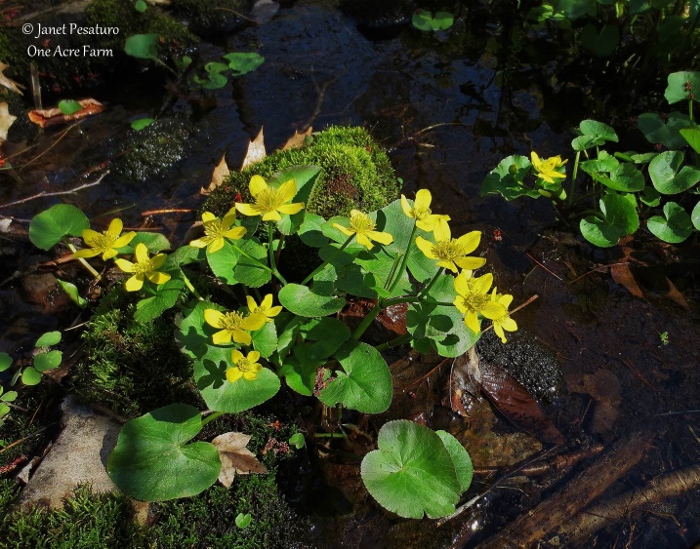
Gardening for Pollinators: 8 Tips. Marsh marigold is a lovely North American native favored by a variety of insects for pollen and nectar.
The potential for gardeners to support pollinators with native plants in their own backyards, is huge. Non-native species are crowding out native plants even on some of our conservation lands, and sometimes cannot be sufficiently controlled without – you guessed it – herbicides. That’s exactly what we want to avoid. But we gardeners can choose native plants for your backyard. We can pamper them and weed around them so they will not be outcompeted by non-native plants. We can maintain them without herbicides.
Does that mean everything in your yard must be native? No. If it did, we’d have to say good bye to most of our garden vegetables, too. You don’t need to be a fanatic. But do look f0r native alternative to invasive garden plants. Here are some books that can help you do just that:
3. Provide a wide variety of flowering plants
There are tens of thousands of different pollinators, including bees, wasps, flies, beetles, butterflies, moths, hummingbirds, and bats. Do you have time to learn all of the pollinators in your region, and their their favorite flowers and larval host plants? No matter. Providing a wide variety of plants should cover a wide variety of pollinators. This is what I mean by variety:
- A mix of trees, shrubs, vines, and herbaceous plants.
- Plants that bloom at different times of year, so that pollen and nectar will be available from early spring through late fall.
- Plants with flowers of different color, shape, and size.
If you do want to learn more about the many different types of pollintors, here are some excellent books:
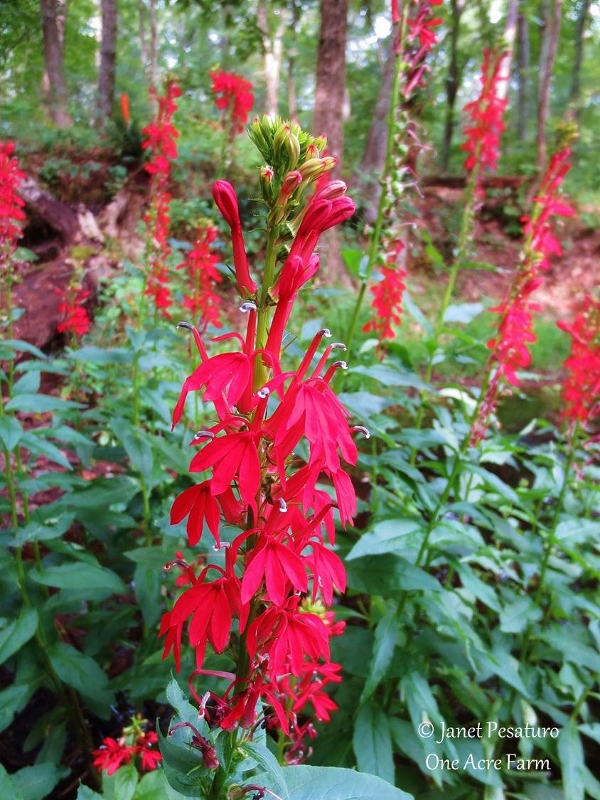
Gardening for Pollinators: 8 Tips. One helpful tip is to plant flowers of various forms. The cardinal flower’s unusual shape is perfect for hummingbird pollination.
4. Grow larval host plants
The larvae (caterpillars) of each butterfly and moth species typically feeds on only a few types of host plants. Without their specific host plants, butterflies and moths cannot reproduce! A well known example is the monarch butterfly caterpillars’ need for milkweed. Check out this list (and nice photos) of some common butterflies and moths, and their host plants here.
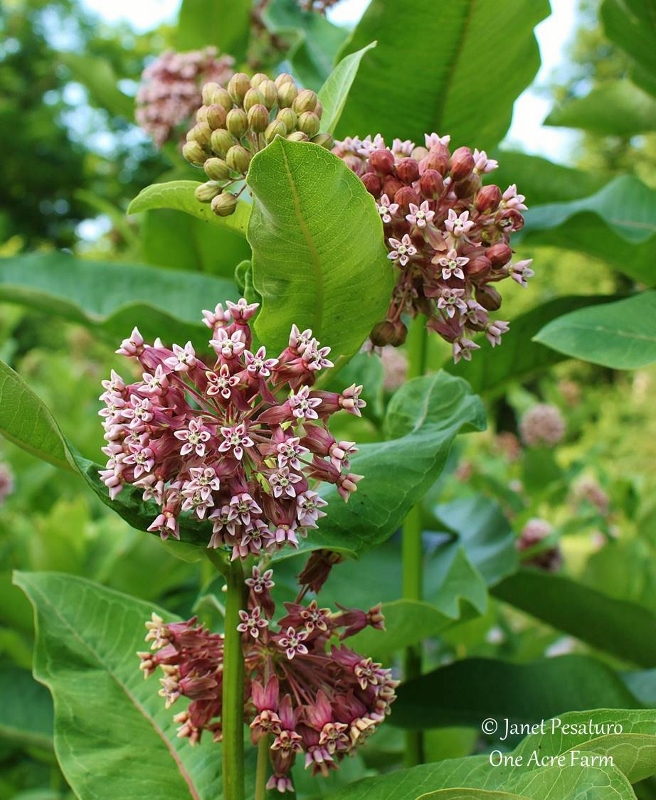
Gardening for Pollinators: 8 Tips. One tip is to provide larval host plants. Common milkweed, for example, is the host plant for monarch butterfly larvae.
5. Let a patch of your lawn grow weedy
If you let a patch of your lawn grow weedy, mowing only once a year, wildflowers have a chance to bloom, attracting more pollinators. But try not to mow before late summer, to be sure that any ground nesting birds have already moved on. The folks at Homestead Mania have a “bee lawn”, and you can check out their photos and read more about it here.
6. Leave dead trees/limbs

Gardening for Pollinators: 8 Tips. One step is to leave standing dead trees. Some insects nest in little tunnels in decaying trees. The dead wood also provides food and shelter for many other organisms, including birds and mammals.
Dead trees (snags) and limbs are valuable resources for many types of wildlife, including certain pollinators. Some insect pollinators nest in the tunnels created by wood boring beetles in snags. Bumblebees (not to mention many bird and mammal species) sometimes nest in cavities within snags. And, decomposing organisms make use of the snags after they fall and become logs.
A lot of people consider snags and dead branches unsightly, but try to retain some of them. If they are a threat to your house or power lines, trim no more than necessary, allowing some of the dead wood to remain for pollinators and other wildlife.
7. Build an insect hotel
If you cannot leave snags standing, you can make “insect hotels” with tunnels for certain bee, or nesting boxes for bumblebees. (Bumblebees once nested in a nesting box I had set up for small songbirds.) These are fun and educational, projects for both adults and kids. For some fabulous ideas with spectacular photos, check out this site.
However, I want to emphasize that snags and dead tree limbs are superior wildlife resources, because they benefit a great myriad of species, from insects to birds to mammals, while insect hotels and nesting boxes are used by fewer species.
8. Support conservation organizations
Habitat loss is one of the greatest threats to all kinds of wildlife, pollinators included. Therefore, supporting conservation organizations with donations or volunteer time, is a great way to contribute to pollinator conservation. Doing whatever you can in your own backyard is great, but some things must be done on larger scale.

Gardening for Pollinators: 8 Tips. One tip is to support land conservation. Pink lady slippers are difficult to grow in the garden, but thrive in the right forest habitat.
Conservation organizations can protect entire forest tracts which are home to woodland wildflowers, shrubs, trees, and snags. They can protect many other plant communities, including meadows, shrublands, wetlands, and more, that you might not have in your backyard. In short, they can provide for a greater diversity of pollinators and other wildlife.
Do you have any questions or comments about gardening for pollinators? Please share your thoughts and experiences in a comment below!
Sources for further reading:
- Great Pollinator Project: Nesting Habitat
- The Xerces Society
- Protecting Pollinators: Why and How Pesticide Applicators Can Help Them
- How to Build Nests for Native Bees
- Pollinator Conservation Seed Mixes
- Center for Pollinator Research
Shared on: Tuesdays with a Twist, Backyard Farming Connection #88, Wildcrafting Wednesday #139, Wonderful Wednesday Blog Hop #82, Homestead Barn Hop #169











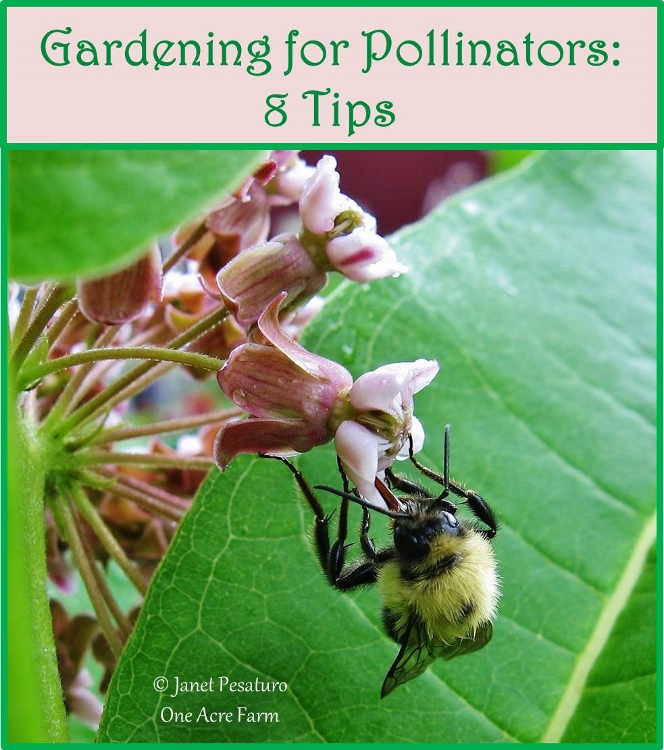
I love, love, love this article! Lots of great pointers that many of us wouldn’t know are helpful to pollinators – like growing larval hosts and leaving dead limbs. Lots of beautiful photos too. Thanks for summing this up so well, Janet. I’m sharing!!
Thanks so much, Jennifer!!
Pingback: My Week on Wednesday… July 9 » Once Upon a Time in a Bed of Wildflowers
Excellent tips for pollinators. I’ll share this with my seed customers if that’s okay…Thank you for sharing at Tuesdays with a Twist. YOU have been featured today at Back to the Basics!!!
Thank you so much, Mary! Please DO feel free to share this with your seed customers!
Hey, Janet! I loved this post so much I’ve decided to feature it on the From the Farm Blog Hop this week! 🙂
Thanks for writing a great post on how to keep our little pollinators safe and well-loved. I hope you’ll join us again this week!
~ Christine
Many thanks, Christine,I am honored!!
Pingback: From the Farm Blog Hop… Gardening for Pollinators » Once Upon a Time in a Bed of Wildflowers
Pingback: 4 Reasons I Want Bees (And Why You Should Consider Them Too!) | The Flip Flop Barnyard
Pingback: 10 Selfish Reasons to Protect Biodiversity - One Acre Farm
Pingback: How to Start a Backyard Farm - One Acre Farm
Pingback: My Week on Wednesday… And a Year in Review » Once Upon a Time in a Bed of Wildflowers
Pingback: Guide to Growing Sunflowers - One Acre Farm